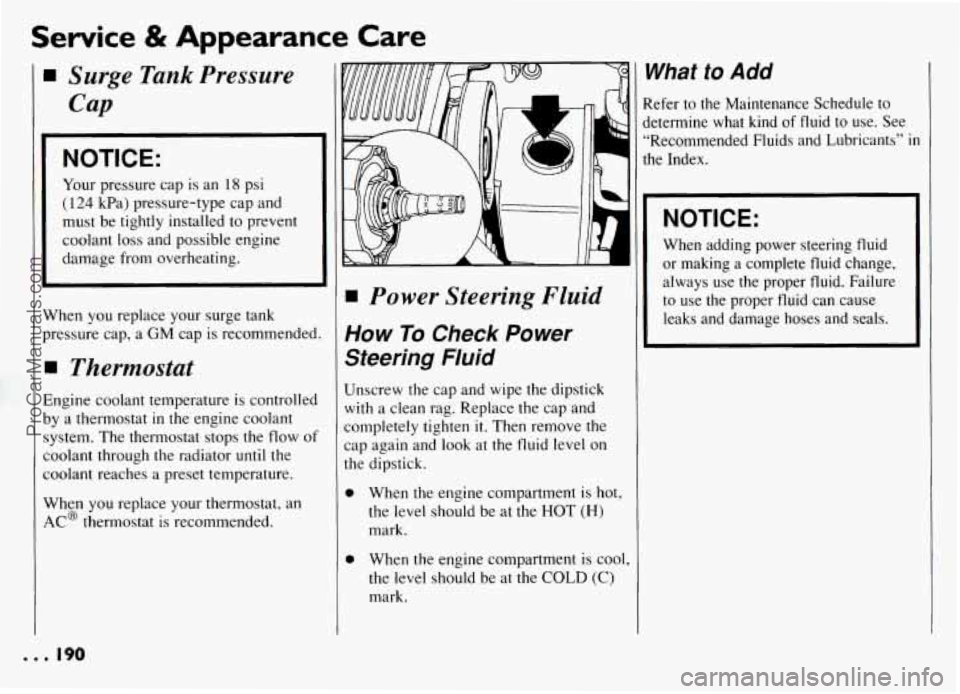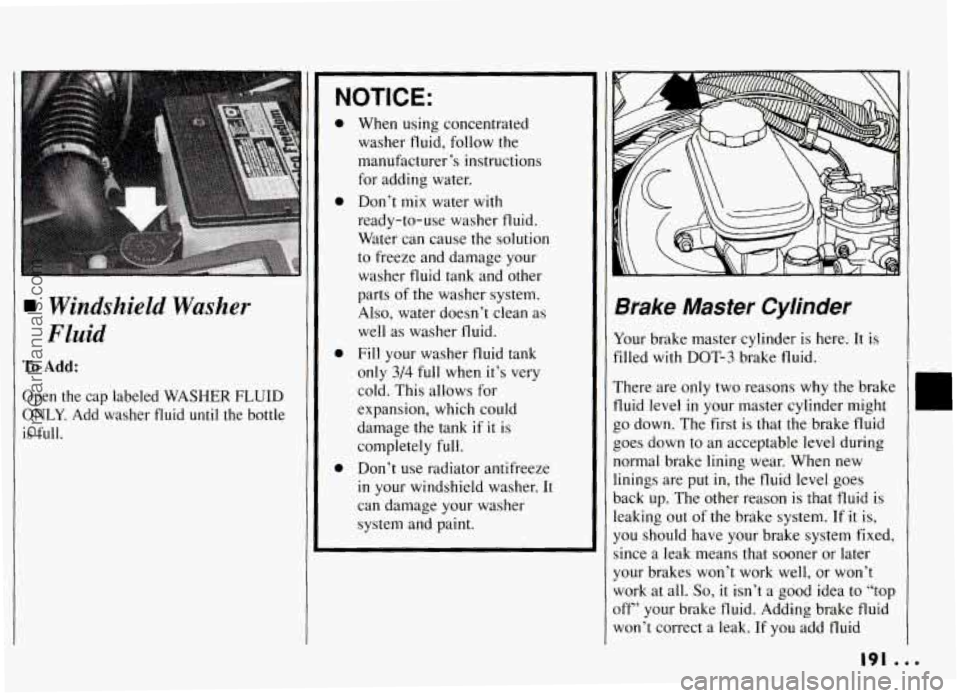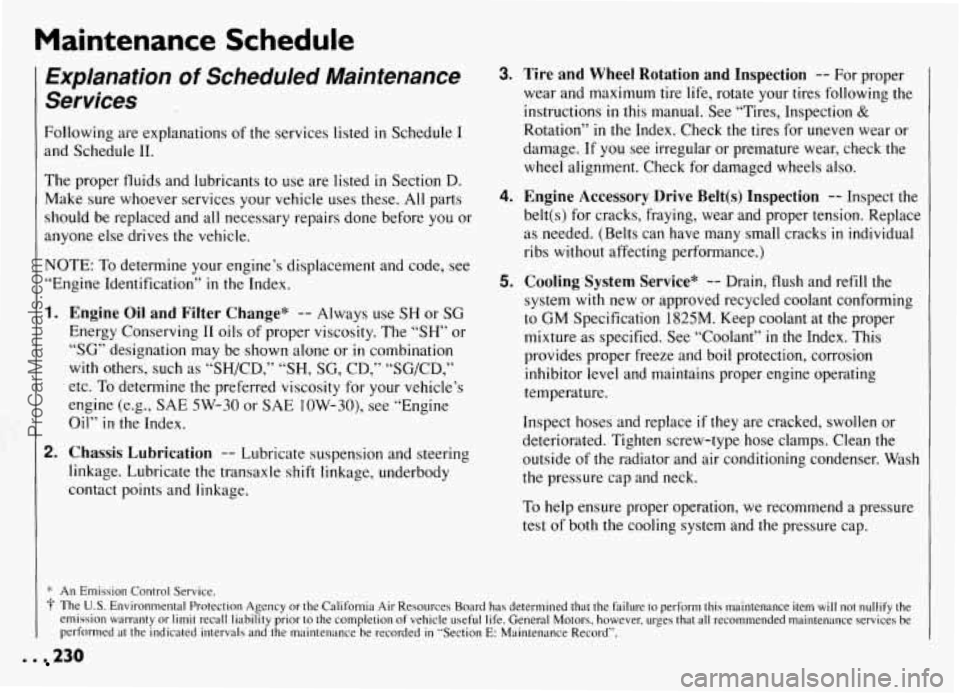1994 PONTIAC GRAND-AM radiator
[x] Cancel search: radiatorPage 191 of 274

Service & Appearance Care
V
P
I
E
b
S’
C
C.
P
A
I Surge Tank Pressure
Cap
NOTICE:
Your pressure cap is an 18 psi
( 124 kPa) pressure-type cap and
must be tightly installed to prevent
coolant
loss and possible engine
damage from overheating.
irhen you replace your surge tank
ressure cap, a GM cap is recommended.
I Thermostat
lngine coolant temperature is controlled
y a thermostat in the engine coolant
ystem. The thermostat stops the flow
of
oolant through the radiator until the
oolant reaches a preset temperature.
Jhen you replace your thermostat, an
.C@ thermostat is recommended.
Power Steering Fluid
How To Check Power
Steering Fluid
Unscrew the cap and wipe the dipstick
with a clean rag. Replace the cap and
completely tighten
it. Then remove the
cap again and
look at the fluid level on
the dipstick.
0
0
When the engine compartment is hot,
the level should be at the HOT
(H)
mark.
When the engine compartment is cool,
the level should be at the
COLD (C)
mark.
1
I
1
What to Add
Refer to the Maintenance Schedule to
jetermine what kind
of fluid to use. See
“Recommended Fluids and Lubricants”
in
the Index.
NOTICE:
When adding power steering fluid
or making a complete fluid change,
always use the proper fluid. Failure
to use the proper fluid can cause
leaks and damage hoses and seals.
... 190
ProCarManuals.com
Page 192 of 274

NOTICE:
1 Windshield Washer
Fluid
To Add:
Open the cap labeled WASHER FLUID
ONLY. Add washer fluid until the bottle
is full.
a
e
a
a
When using concentrated
washer fluid, follow the
manufacturer’s instructions
for adding water.
Don’t
mix water with
ready-to-use washer fluid.
Water can cause the solution
to freeze and damage your
washer fluid tank and other
parts of the washer system.
Also, water doesn’t clean as
well as washer fluid.
Fill your washer
fluid tank
only
3/4 full when it’s very
cold. This allows for
expansion, which could
damage the tank if
it is
completely
full.
Don’t use radiator antifreeze
in your windshield washer. It
can damage your washer
system and paint.
Brake Master Cylinder
Your brake master cylinder is here; It is
filled
with DOT-3 brake fluid.
There are only two reasons why the brake
fluid level
in your master cylinder might
go down. The first is that the brake fluid
goes down to an acceptable level during
normal brake lining wear. When new
linings are put
in, the fluid level goes
back up. The other reason
is that fluid is
leaking out of the brake system.
If it is,
you should have your brake system fixed,
since a leak means that sooner or later
your brakes won’t work well, or won’t
work at all.
So, it isn’t a good idea to “top
off’ your brake fluid. Adding brake fluid
won’t correct
a leak. If you add fluid
191 ...
ProCarManuals.com
Page 231 of 274

Maintenance Schedule
Explanation of Scheduled Maintenance
Services
Following are explanations of the services listed in Schedule I
and Schedule 11.
The proper fluids and lubricants to use are listed in Section D.
Make sure whoever services your vehicle uses these. All parts
should be replaced and all necessary repairs done before you or
anyone else drives the vehicle.
NOTE: To determine your engine’s displacement and code, see
“Engine Identification”
in the Index.
1.
2.
Engine Oil and Filter Change* -- Always use SH or SG
Energy Conserving I1 oils of proper viscosity. The “SH” or
“SG” designation may be shown alone or in combination
with others, such as “SH/CD,” “SH, SG, CD,” “SG/CD,”
etc. To determine the preferred viscosity for your vehicle’s
engine (e.g., SAE 5W-30 or SAE 10W-30), see “Engine
Oil”
in the Index.
Chassis Lubrication -- Lubricate suspension and steering
linkage. Lubricate the transaxle shift linkage, underbody
contact points and linkage.
3.
4.
5.
Tire and Wheel Rotation and Inspection -- For proper
wear and maximum tire life, rotate your tires following the
instructions
in this manual. See “Tires, Inspection &
Rotation” in the Index. Check the tires for uneven wear or
damage. If you see irregular or premature wear, check the
wheel alignment, Check for damaged wheels also.
Engine Accessory Drive Belt(s) Inspection -- Inspect the
belt(s) for cracks, fraying, wear and proper tension. Replace
as needed. (Belts can have many small cracks
in individual
ribs without affecting performance.)
Cooling System Service* -- Drain, flush and refill the
system with new or approved recycled coolant conforming
to
GM Specification 1825M. Keep coolant at the proper
mixture as specified. See “Coolant”
in the Index. This
provides proper freeze and boil protection, corrosion
inhibitor level and maintains proper engine operating
temperature.
Inspect hoses and replace if they are cracked, swollen or
deteriorated. Tighten screw-type hose clamps. Clean the
outside of the radiator and air conditioning condenser. Wash
the pressure cap and neck.
To help ensure proper operation, we recommend a pressure
test of both the cooling system and the pressure cap.
. . 230
ProCarManuals.com
Page 268 of 274

Lights on Reminder .............. 77
Loading Your Vehicle
........... 197
Locks. Door
.................... 47
Automatic Door Lock .......... 48
Rear Door Security Locks
...... 49
Low Battery
................... 149
Low Oil Pressure Warning
...... 95. 96
Lubricants and Fluids
............ 238
Lumbar Support
.................. 9
Maintenance Record ........... 240
Maintenance Schedule
........... 223
Maintenance Services. Scheduled
. . 225
Malfunction Indicator Lamp
...... 100
Manual 4-Way Adjustable Seat ...... 8
Manual Front Seat ................ 8
Manual Lumbar Support
........... 9
Manual Transaxle
Adding Fluid ............ 187. 215
Checking Fluid
.............. 186
Parking
..................... 69
Shifting
..................... 64
Starting Your Engine
........... 56
Upshift Indicator Light
......... 67
Master Cylinder. Brake .......... 191
Methanol in Gasoline ........ 171. 172
Mileage Indicator (see “Odometer
Mirrors
& Speedometer”)
Convex Outside .............. 83
Inside Manual Daymight
....... 82
Manual Remote Control
........ 83
I
I
I
I
I
I
1
Power Remote Control ......... 84
Mountain Driving
............... 134
New Vehicle “Break-In”
Requirements .................. 54
Night Driving
.................. 129
Night Vision
................... 129
Octane Requirements (see “Fuel
Requirements”) ............... 17 1
Odometer
& Speedometer ......... 92
Off Road Recovery
............. 127
Oil. Engine
.................... 179
Pressure Gage ................ 96
Quality
.................... 180
Thickness .................. 180
Used Oil
................... 182
When to Change
.............. 182
Operation of Lights .............. 77
Outside Rearview Mirrors
......... 83
Overheated Engine
.............. 156
Overheated Engine Coolant Warning
Light ......................... 94
Owner Checks
& Services ........ 232
Oil Warning Light ............... 95
Parking
On Hills .................... 145
With the Engine Running
.... 68. 70
Parking Brake
................... 66
Over Things That Burn ......... 69
Park . Shifting Into ............ 60. 67
Passenger Belts (see “Safety Belts”)
Passenger Side Cup
Holder/Storage Area ............ 85
Passing
....................... 127
Polishing and Waxing (see
Power Door Locks ............... 48
Power Mirrors
.................. 84
Power Seat Controls
............... 9
Power Steering Fluid ............ 190
Power Window Lock-Out Switch ... 72
Power Windows
................. 72
Pregnancy. Use of Safety Belts
During ....................... 26
Problems on the Road
........... 147
Publications (see “Service
Publications”) ................ 250
Radiator Overheating
(see “Overheated Engine”) ....... 156
Radio (see “Audio Systems”)
..... 106
Reading Lights
.................. 79
Rear Door Security Locks
......... 49
Rear Safety Belt Comfort Guides
... 30
Rear Seat. Split Fold-Down ........ 11
Rear Window Defogger
.......... 105
Rearview Mirrors ................ 82
Reclining Seatbacks
............... 9
Recommended Fluids
& Lubricants 238
Remote Fuel Filler Door
......... 174
Remote Trunk Release
............ 53
Replacement Brakes
............. 193
“Appearance Care”)
267 . .
ProCarManuals.com